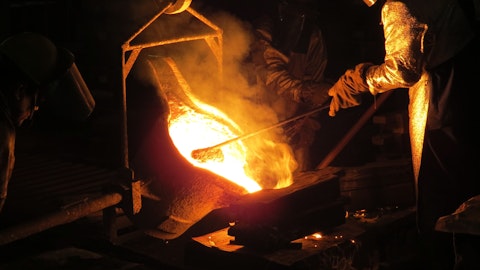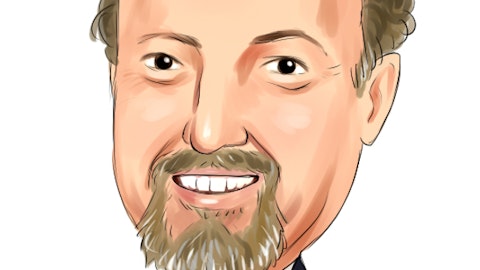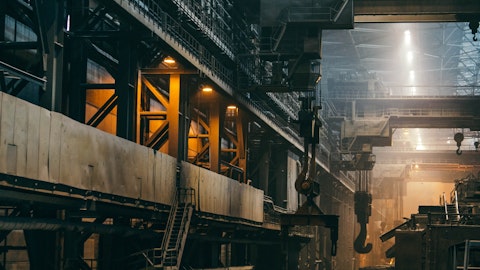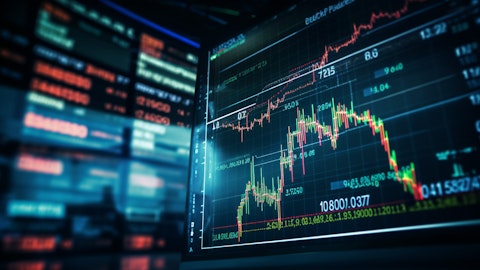Companhia Siderúrgica Nacional (NYSE:SID) Q4 2023 Earnings Call Transcript March 7, 2024
Companhia Siderúrgica Naciona isn’t one of the 30 most popular stocks among hedge funds at the end of the third quarter (see the details here).
Operator: Good morning, ladies and gentlemen, and thank you for holding. At this time, we would like to welcome everyone to CSN Conference Call to present results for the Fourth Quarter 2023. Today with us, the Company’s executive officers. We would like to inform you that this event is being recorded, and all participants will be in listen-only mode during the Company presentation. Ensuing this, we will go on to the Q&A section when further instructions will be provided. This event is being webcast through internet and can be accessed at ri.csn.com.br, where the presentation is also available. The replay of this event will be available for a period of seven days. Before proceeding, please be advised that some of the statements herein are mere expectations or trends and are based on the current assumptions and opinions of the Company management and the performance and events may differ materially from those expressed herein, which do not constitute projection.
In fact, actual results, performances, or events may differ materially from those expressed or implied by forward-looking statements as a result of several factors such as overall and economic conditions in Brazil and other countries, interest rates and exchange rate levels, future rescheduling or prepayment of debt nominated in foreign currencies, protectionist measurements in the U.S., Brazil, and other countries, changes in law and regulations and general competitive factors at a global, regional, or national basis. I’d now like to turn the floor over to Mr. Marcelo Cunha Ribeiro, CFO and Investor Relations Executive Officer, he will present the operational and financial highlights for the period. Mr. Ribeiro. You may proceed.
Marcelo Ribeiro: Good morning, everybody, and thank you for attending CSN’s conference call. As usual, I will go on to the presentation. And before going on to the question and answer session, I will give the floor to Mr. Benjamin Steinbruch. Now we had a strong EBITDA of R$ 3.6 billion in the fourth quarter, confirming the robustness of the CN model of diversification, integration, and verticalization, reaching an EBITDA margin of 29%, even in difficult moments for the production of steel, and because of the prices that are dropping. Despite this, we achieved the best results in the year through this diversification. Second highlight, a strong cash generation, R$ 387 million, which enabled us to reduce our indebtedness. Even with the seasonality, we have better sales of cement and steel.
And as a third highlight for second consecutive quarter, we were able to decline the leverage rate. So we have had a significant reduction now. To continue on with the presentation on page 4, we see the EBITDA evolution. We ended the year with the strongest EBITDA margin, R$ 3.6 million, a growth of almost 30% sequentially, thanks to the excellent performance of mining. But all of the businesses and the company contributed in steel. We practically increased the results twofold. We had a good performance in price, which was surprising because of the former price behavior but we focused on volume in cement. We had good results with the seasonality hampering results at the end of the year and in MRS very good results as well as in energy because of the recent price recovery of energy in the Brazilian market.
We ended the year at R$ 11.9 million, a decrease vis-à-vis 2022 because of the more difficult moment in the steel sector. We continue to speak about cash generation. We had an important evolution in the CapEx for half of the year. Perhaps this was the highest, CapEx R$ 1.6 million. It’s good news because it shows the rapid evolution of projects that are relevant for the company. In the case of mining, not only P15 has progressed steadily, but we have a more robust sustaining, showing good results in the short term, a better result at the port. And this is how we will continue going forward as we are aligned with the guidance for 2024. In the case of steel, this additional CapEx was used in the reform of the coke batteries. Our cost here was significant, and we have accelerated the operational recovery of important parts of our production process, the steel mill sintering.
So this CapEx had been planned, and it will enable us to reach our results in 2024. In working capital, we had a natural increase in inventory, offset, of course, with the term given to suppliers, and in line with the normalization of our lines. We continue on with the 400 and some million reals for our cash flow. Cash flow is very close to being neutral. It’s a combination of a strong cash generation in mining and a more difficult year in steel, where the margins are tighter and, of course, significant CapEx for the projects. But it shows you how robust our model is. It allows this cash generation at difficult moments of the production. We had an EBITDA. We used our CapEx. And of course, we had income tax. Now on the next page, cash generation was relevant for the second consecutive quarter.
It helped us reduce our leverage, practically reaching our guidance of 2.5x at the end of 2023. But still far of what we would like to do to reach the 2x at the end of 2024. We’re fully committed to this figure. And throughout 2024, the tendency is to reach that level not only because of EBITDA evolution, but we’re also seeking a partner for our energy business. This allows us to think we will have a reduction net debt very close to the level of the third quarter with an evolution of 2.5%, thanks to the cash generation and an exchange rate that was favorable offset by the dividends paid in the period and because of the MRS that is partially consolidated and leading to greater investments to renew the concession. This means we will have a better operational performance of this subsidiary and this proportional consolidation should not have an impact on our position of indebtedness in times of net debt.
It was higher this quarter by R$ 48 million because of the fundraising we carried out in the international market at the end of 2023. We have reached our highest levels of R$ 16 billion, but this is important because of the maturities that we have and the banking debt in 2024-25. This level of liquidity will enable us to manage these short term liabilities with comfort and efficiency. We will continue using the capital market to lighten up our indebtedness. We have two good outlooks of using incentivized instruments for the short term at CSN mining and our subsidiary. So this is the path of a continuous lengthening and efficiency in management of the indebtedness besides a reduction of our debts, of course, this should allow us to materialize this positive outlook to have a good new upgrade at the end of the year.
In a medium and long term, we will continue towards achieving an investment grade, which is one of our strategic goals. To speak about steel, we highlight the evolution of volume. For the fourth consecutive quarter, we had growth in the domestic market. And this is a clear indication of the recovery we had after a very limited first half in terms of volumes at the steel mill ending the year with the quarter with the best volume. Despite this, we had a drop of 5 % during the year due to this issue and due to perhaps hyperbolic and un-loyal competition of imported steel. In net revenues, we had a positive evolution. This is the eighth consecutive quarter of price drops in the domestic market. We had an update in prices internationally, especially in the United States.
The average price increased vis-a -vis the third quarter for the first time in many years. And this is a good forecast of what we may see during 2024. We have already announced prices and it shows our capacity to react on this top line for the coming quarters. Regarding EBITDA, we increased it twofold with very low margins in the third quarter. We have reached 6% and we had a positive evolution in costs. In the next slide, we see that we had 900 tons of plate processing during the half of the year, as we mentioned in the third quarter. And because of normalization of raw material, this is the third consecutive quarter for a drop in prices. And of course, the unit EBITDA is still far from what it should be at this moment of the steel cycle. There is a great deal of space to continue improving not only because of the market but because of our operational evolution.
We’re convinced that throughout the semesters we will have a sequential enhancement of this indicator. We will now speak about mining that had a very strong year, almost perfect operational performance that was truly very good throughout the process beginning with the mine, the central plant, filtering, loading at the port and that is why we had these production and sales records going beyond our guidance for the year, a growth of sales of 28% which is quite atypical in an operation of our size. This was accompanied by a good evolution in the market and a drop in prices. The unit price increased more than 20% not only because of a good level of iron ore prices internationally but due to our quality that has had a good evolution. The central plant is working better, we increase this steel content and we’re also at a very positive moment because the Chinese steel is seeking iron ore that has a lower quality and low margins.

So we had margins above 54% and EBITDA of R$ 2.7 billion because of a lower cost not only because of operation but because we had a greater amount of our own iron ore and all of this has benefited us with these high margins. We see this very clearly in the next slide. We show you that all of the variables were positive aiding and abetting the results. We only had drops because of seasonality offset by a better mix, better quality, less purchase from third parties, lower cost, higher prices and also because of the increase of provisions we got to an EBITDA of R$ 2.7 billion. Regarding cement, we continue to have a very robust sales volume which testifies to our capacity of distribution through the new platform. We are working with LafargeHolcim.
We have a growth year-on-year of 7%, a market environment where the market had a retraction. Once again, this points to our capacity of working better with fragmented markets and better logistic, and because of seasonality, a slight drop of 4%, a drop of revenue of 6%, and the average prices are responsible for this because of seasonality and because we’re still recovering from the retail construction. We believe that 2024 will allow for better readjustments as we have a better demand. But even with lower average prices, we had a positive evolution of margin. Thanks to the synergy of expenses and costs that enabled us to get to an EBITDA margin of 24%. Seeking the margins we had before the integration with LafargeHolcim that were 30%, this is what we will seek for the coming quarters.
With this we end the presentation of the business. I give the floor to Helena to speak about ESG.
Helena Guerra : Good day, everybody. Thank you for the opportunity of presenting our results for the quarter. Now these results are presented through an independent specific release and the data is consolidated and will be published in an integrated report in April. As the main highlights of the period, we have maintained the stability of our dams. In ’23, we went from level 2 to 3 in July. We have a request for recognition of this stability and the license will be issued now after an auditing. We also had an evolution of course. We ended up with the lowest accident frequency rate and this includes all types of accidents and in December we began a specific program to prevent accidents with high fatality rates. A great highlight for the period is our new goal for cement and new target.
And this goal, of course, will be aligned with the global indices. Now cement corresponded to more than 40% of our rates in CSN, the highest in the group. We continue to make strides in diversity, especially when it comes to the representativity of women. We went up to 60% in 2023 with specific advances of women in roles of leadership. And finally, the evolution of the company and the main ratings of the world, SMP, our results in CDP, perhaps this CDP has one of the largest data banks in the world and we are part of that platform. We are leaders in environmental management in a scale that disclosed their results and we went from B in 2019, we got to A minus in 2023 and all of this referring to water safety and several other indicators and all of our platforms have this level of performance and you can observe the great challenge it has been to achieve these figures.
Thank you once again for your attendance.
Marcelo Ribeiro: Thank you, Helena and before we go on to the questions, we would like to turn the floor over to our Chairman Mr. Benjamin Steinbruch.
Benjamin Steinbruch: Good morning, everybody, thank you for attending the CSN earnings conference call. I would like to address a few words to you basically referring to last year. Our businesses very generally did very well with a greater focus on steel as you know in cement, we worked very well almost 3 million tons with a margin that is once again going back to what it used to be Marcelo mentioned that we had 30% before we acquired LafargeHolcim, we are resuming to those levels. We have 24% of margins and of course we will continue to seek out the 30% and because of the maturity and the growing synergies of our businesses, we will be able to continue recovering these margins working fully and has always been our purpose to work at full steam and to intelligently work with the distribution of cement throughout the Brazilian territory, logistics and infrastructure with a very good performance, MRS, Tecon, Tecad and the North East Railroad and the [inaudible] Railroad at a somewhat more accelerated pace at present.
And they have proven to be very good businesses, important for the future of the CSN group. In energy, the prices have been reacting quite speedily and with increases, which allows us to believe that the year 2024 will end up being a very positive year for energy business. Mining, as you were able to see, was excellent. It continues to have an excellent performance, where on the growth, not only in terms of quantity but also quality. We had good deliveries last year and without a doubt we will perform even better this year. Of course, continuing on with that pace of growth that we showed in the third and fourth quarters of 2023. And steel has now moved away from that uncomfortable situation we placed ourselves in. We already have results that are better not only in terms of quantity but also decrease of costs.
And in the last quarter of last year we were able to show that the first quarter of 2024, the improvement should continue on. All of the measures that had to be adopted have been taken and we believe we will continue on with our recovery when it comes to the amounts produced as well as regarding the lower costs that we are seeking actively which is part of our job. Now with this, our growth policy which is the main premise that we work with followed by a deleveraging that we mentioned should stand at 2.5x. We intend to continue to reduce this leverage even with the growth and the payout of dividends and as you know, we’re seeking a partner for the energy business. We have that desire to open up our capital in cement to hold an IPO and we’re also interested in seeking out more capital for the challenges we face in mining.
With all of this done, I am convinced that we will continue to grow, we will continue to deleverage, pay out dividends and enhancing the longevity of our businesses. Basically, this is what I wanted to mention. Thank you very much for your attention. We can go on to the questions and answers.
See also 16 Countries with Most Chinese Expats and Warren Buffett’s 35 Best Quotes About Business, Investing, and Life.
Q&A Session
Follow Companhia Siderurgica Nacional (NYSE:SID)
Follow Companhia Siderurgica Nacional (NYSE:SID)
Operator: [Operator Instructions] Our first question comes from Daniel Sasson from Itau BBA
Daniel Sasson: Good morning. Thank you all. Thank you for taking the question. My first question is to Benjamin. In your final statement, you said you’re seeking capital for the challenges you have in mining. Would it make sense to hold a follow on operation to raise cash for mining and perhaps increase the company’s brief load, or is this not the option? Perhaps you are referring to strategic partnerships or a free sale of iron ore through agreements as you announced previously with Glencore along those lines an attempt of IPO for the cement business perhaps could be something for the short term. You attempted to do this in the past and I believe the unit is one step ahead of all others. So which are the preparations to replicate this intention of having each CSN vertical becoming self-sufficient standalone companies with more currency to grow?
My second question refers to Martinez. Martinez, we have seen an improvement in the steel production cost with the price of steel dropping in the domestic market. This hampers your margin. We see that the steel plant is below the potential it could deliver. So which are the main drivers for a margin enhancement that you foresee from coming quarters? Will this come from sequential reductions of cost in slab, for example? Or does this depend on stronger efforts in terms of pricing? Thank you for taking my questions.
Benjamin Steinbruch : Danial, thank you for the question. And I will respond in terms of mining because of the fact that it has already been listed. This question of follow-on exists, but it is not our priority. Perhaps we will continue seeking out a strategic partner for the challenges that we face in terms of mining. And these are areas of challenges. We’re referring to 25%, 30%, 40% of return in our peripheral projects that would have lower investments but would have a higher and faster return. Perhaps seek partners that could make these investments feasible to have a faster return in the mining. balance. We are open, as we have always been, to strategic capital that could add value more than the market for these specific opportunities.
And because of our very strong growth and investment plan that we have in mining, it would allow us to do this. As you know, we have extremely good assets. We have 80% of control on mining, which means we have sufficient space to make strategic decisions that will enable us to advance at a faster pace with these peripheral projects, make them feasible and have short-term return. Basically, this is what we foresee for mining. As you yourself have mentioned, we have five businesses that we would like to have separate independent businesses that will be listed, standalone businesses. Mining has already been listed. We have cement where we continue to have that desire to hold an IPO, as well as in our other three businesses. And our proposal is that they become independent and listed companies as soon as possible and that this capital opening become something viable.
Our idea for growth, which I have mentioned previously, is always as a function of having a better route to market. We believe that larger businesses where we can materialize the synergies we have obtained through the acquisition, making the businesses larger and better, ensure that they will be more attractive to open up capital. Cement is on a path to that and of course we will do the IPO as soon as the market allows for this. For some time already we have been speaking about having separate and listed businesses and we’re going to do this because of our second greatest priority, which is deleveraging. We want growth and we have that commitment with deleveraging and this is how we can achieve this and allow for a payment of dividends which of course is a third priority that we would like to maintain.
When it comes to mining therefore there is that concrete possibility, we have investment for the very rapid return that we’re offering to third parties to make this feasible so that we can continue to focus on our main challenge which is the P15 and eventually we would like to offer this higher added value product with a higher iron or content to the market better complying with environmental standards in cement. This would be very natural. We have been trying to open up capital with growth, of course, LafargeHolcim has been fully integrated and is working at full steam this year. We want to grow. We will grow with temporary leverages because our challenge is to maintain low leverage and work with a structured operation and go to market in infrastructure and logistics.
We’re also considering this, as Marcelo mentioned, in energy, we’re seeking a strategic partner in the acquisition as a model. The idea was a 50%-50% partnership. It all ended up being a last-minute affair, but we do want to go back to this possibility of having a strategic partner in the business to allow for organized growth. Basically, this is it. Our strategy remains unaltered and our commitment was, is and will continue to be one of growth, deleveraging the payment of dividends and the longevity of our business.
Luis Martinez: Thank you, Benjamin. Hello, Daniel. Good morning. Regarding the recovery of margins, an important point to begin this. I’m quite optimistic despite the market that was somewhat hostile at the beginning of the year. And of course, I depend a great deal on facts and data. If we look at January 2024, there was a growth of 11% in domestic sales. Imports had a drop of 40%. Last year, if we see what happened, apparent consumption grew 3%. Domestic sales dropped because imports were out of the curve. Now, if we imagine that imports will go back to a sustainable level, we’re not speaking about eliminating imports in Brazil, but reducing them to 12% or 11%. I believe the market could grow 10% this year in Brazil. That is a reason to begin to recover margins in the domestic market, recover margins in general.



